A Shepherd’s Journey into Teaching
Written by Mimi Luebbermann
Photos courtesy of the Author
I was always one for starting from scratch. Making bread from a puddle of flour and a wash of water, a few granules of yeast and flakes of salt was just right. I have asked myself, as a knitter, did my compulsion to start “basic “ mean that I had to buy a farm and raise sheep?
Well, evidently it did. As the owner since 1995 of Windrush Farm in Petaluma, California, I raise about 40 sheep, and I would do more if I could, but the restrictions of good stewardship mean I must limit my flock to protect my pastures. Of course, that number doesn’t include the five alpacas, a pair of matching llamas, a pygora goat, and two angora German Giant bunnies. My main flock of sheep is Corriedale-cross, but I have also been raising purebred Shetland sheep for the love of the funny little primitive guys who are extraordinarily good escape artists and individuals in every way. Their lusciously fine fleece pairs nicely with the angora and the alpaca for batts as soft as cashmere and light as dandelion down.
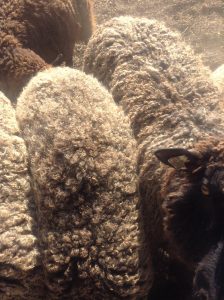
Before shearing
As any shepherd quickly discovers, having sheep means having loads of fleeces, more than any one knitter can entwine into hats and scarves and sweaters. The joy of the harvest, the sweat of the washing, and the lengthy process to untangle those locks into spinning fiber opens the door to the pure pleasure of spinning. So quickly, before the piles of fleece became mountains of fleece, I joined local guilds to find spinners who might need my ladies’ coats. What became very obvious was the fact that there weren’t enough spinners to spin up all my fleeces, and so the
Windrush Fiber School began.
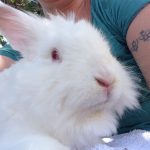
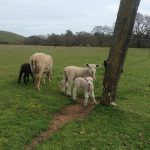
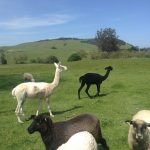
I teamed up with a whirlwind spinner, knitter, garment designer and knitting book author, Marlie deSwart. We began to teach a series of classes from beginning to advanced spinning to natural dyeing, acid dyeing, and garment construction. One of our students suggested she wanted to start from scratch, with the fleece, a suggestion that resonated with me. And so, Marlie and I hatched the Fleece to Garment Fiber Series.
Now in our third year, the Fleece to Garment class begins with shearing day. John Sanchez, an extraordinary North Bay shearer who shears deftly and carefully first tells the class members about his shearing career and he answers questions anyone might have. Then, with the sheep penned and ready, he begins with the Corriedales. We shear at the end of January, just before they start lambing mid-February. The fleeces have been rain-washed with our California winter so they are clean and without vegetable matter.
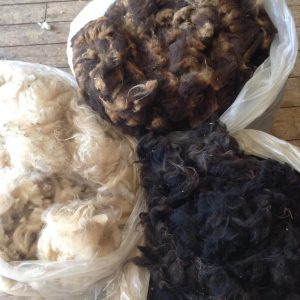
Fleece after shearing
The students lean over the edge of the barn fence watching his every move and asking him questions as he rolls up the fleece and hands it over. Then the fleece goes outside to a skirting table where Ann Brezina, an alpaca shearer and professional classifier discusses the fleece with those students who can tear themselves away from the shearing. There is a delicate jostling as the students claim fleeces, but as the fleeces mount up, still warm from the sheep’s body, it becomes apparent that everyone will be take home a fleece they love.
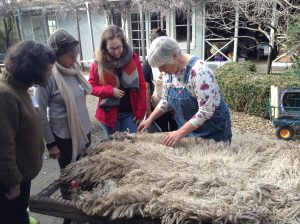
skirting the fleece
That day, usually chilly and wintery, has started with each student discussing what they might like to make from their fleece, and Marlie and I begin our two parallel discussions that will run through the entire series of five classes. One is about fleece, the nature of crimp, luster, micron count, and a finished garment. The other is about spinning the fiber to come up with a yarn that matches the concept of the garment. A Shetland fleece, with short staples and low micron count probably wants to be prepared for a woolen spinning to make a soft, warm cowl. A Corriedale fleece with crimp and luster may need a worsted prep and a semi-worsted spinning for a longwearing vest.
The students need to think about these differences when choosing their fleece. There is a lot to consider in that first class.
All the students must be able to spin a continuous thread, but their levels of spinning ability vary widely. We limit them by presenting three different patterns: a horizontally knit scarf, Marlie’s design for a cleverly constructed vest, and a cowl. We found after the first year, those who were too optimistic or ambitious never finished their projects, or perhaps they did, but long after the class was over. Marlie and I feel the success of designing, spinning, and completing the project is the goal of the series, and we work hard to make sure the students will do just that.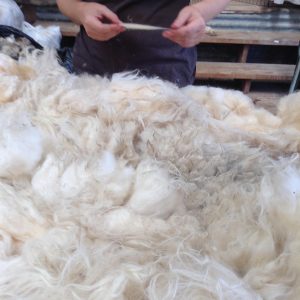
The classes include teaching how to scour a fleece, and we provide cheery, green, 5-gallon buckets for them to take home to wash only one pound of their fleece. Then returning to class with their gorgeous washed fleece, we lead them through the next step of carding their fleece, teaching them also spinning from the cloud, spinning locks, and spinning batts to widen their choices in the construction of their yarn. Continuously, we talk about the relationship of the spinning to the fleece and to their intended garment, and encourage them to think through every step of the process.
As the classes roll by, and the garments begin to emerge, the students’ excitement over their projects brings them all together with an esprit de cour that makes each class a particular pleasure for Marlie and me. It can be tough though, being the guides in this process. One very proficient spinner and knitter came to class with her vest about one half completed but the needle gauge she chose was making a stiff, rigid fabric unsuited to the design. We had to suggest she pull it all out and start with larger needles. I wasn’t sure she would complete the series, but she returned triumphant to the next class with a soft, flowing vest that perfectly suited her yarn.
We celebrate the end of the series with a Fashion Show. Everyone comes with friends and family, and each participant takes the stage and describes their own incredible journey from Fleece to Garment. For those of you who have never tried this process, it is filled with challenge, joy, despair, hard work, and reward.
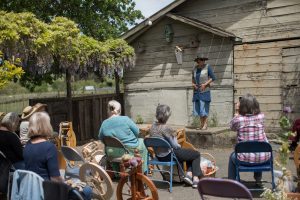
Windrush Fashion Show
Try making your projects from scratch. You may never return to commercial yarn again. I do assure you, you don’t have to buy a farm. There are lots of us out here happy to provide you with glorious fleeces, and the ladies are all out there just growing another crop for the next Fleece to Garment Series.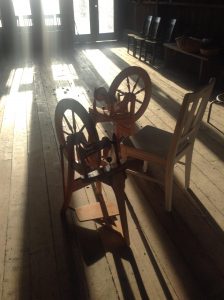
Mimi Luebbermann, Windrush Farm, Petaluma, California. Contact Mimi at: mimi@windrushfarmwool.com and check out her website: windrushfarm.wordpress.com
Marlie deSwart Black Mountain Weavers/Artisans, Pt. Reyes Station, California
Author of Woolscapes, Designs inspired by Coastal Marin Wool